Management Principles and Application for Construction Report
VerifiedAdded on 2021/09/10
|62
|16783
|364
Report
AI Summary
This report examines the application of management principles within the construction and built environment. It covers the evolution of management theories, including Maslow's hierarchy and McGregor's theories, and their relevance to human resource management. The report analyzes organizational structures, such as functional and project-based approaches, and evaluates the impact of contract size and complexity on business practices. It delves into project planning, procurement methods, scheduling, quality control, and risk management. Furthermore, the report explores various procurement methods and contract types, emphasizing their influence on construction firms and projects, offering valuable insights for students studying construction management.
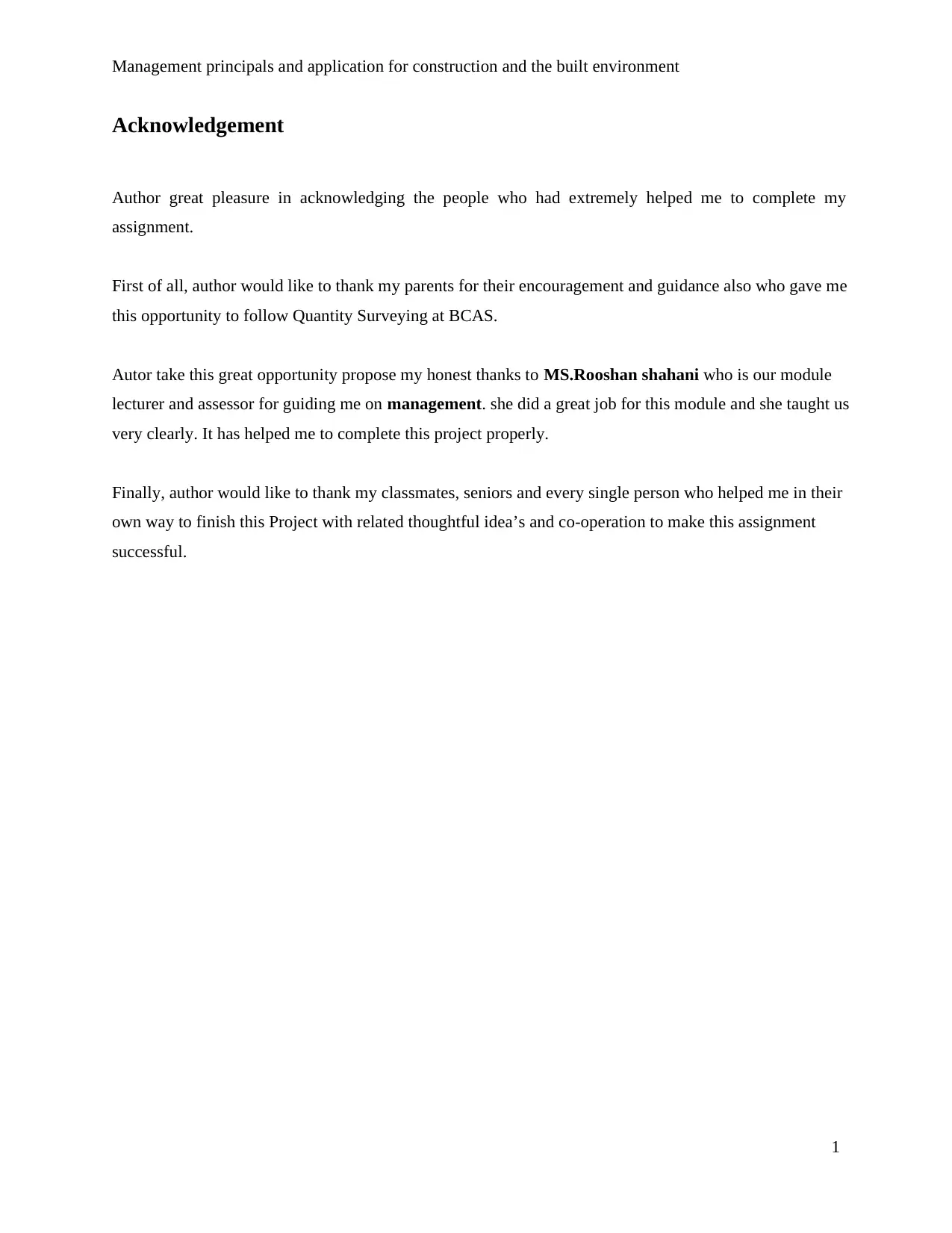
Management principals and application for construction and the built environment
1
Acknowledgement
Author great pleasure in acknowledging the people who had extremely helped me to complete my
assignment.
First of all, author would like to thank my parents for their encouragement and guidance also who gave me
this opportunity to follow Quantity Surveying at BCAS.
Autor take this great opportunity propose my honest thanks to MS.Rooshan shahani who is our module
lecturer and assessor for guiding me on management. she did a great job for this module and she taught us
very clearly. It has helped me to complete this project properly.
Finally, author would like to thank my classmates, seniors and every single person who helped me in their
own way to finish this Project with related thoughtful idea’s and co-operation to make this assignment
successful.
1
Acknowledgement
Author great pleasure in acknowledging the people who had extremely helped me to complete my
assignment.
First of all, author would like to thank my parents for their encouragement and guidance also who gave me
this opportunity to follow Quantity Surveying at BCAS.
Autor take this great opportunity propose my honest thanks to MS.Rooshan shahani who is our module
lecturer and assessor for guiding me on management. she did a great job for this module and she taught us
very clearly. It has helped me to complete this project properly.
Finally, author would like to thank my classmates, seniors and every single person who helped me in their
own way to finish this Project with related thoughtful idea’s and co-operation to make this assignment
successful.
Paraphrase This Document
Need a fresh take? Get an instant paraphrase of this document with our AI Paraphraser
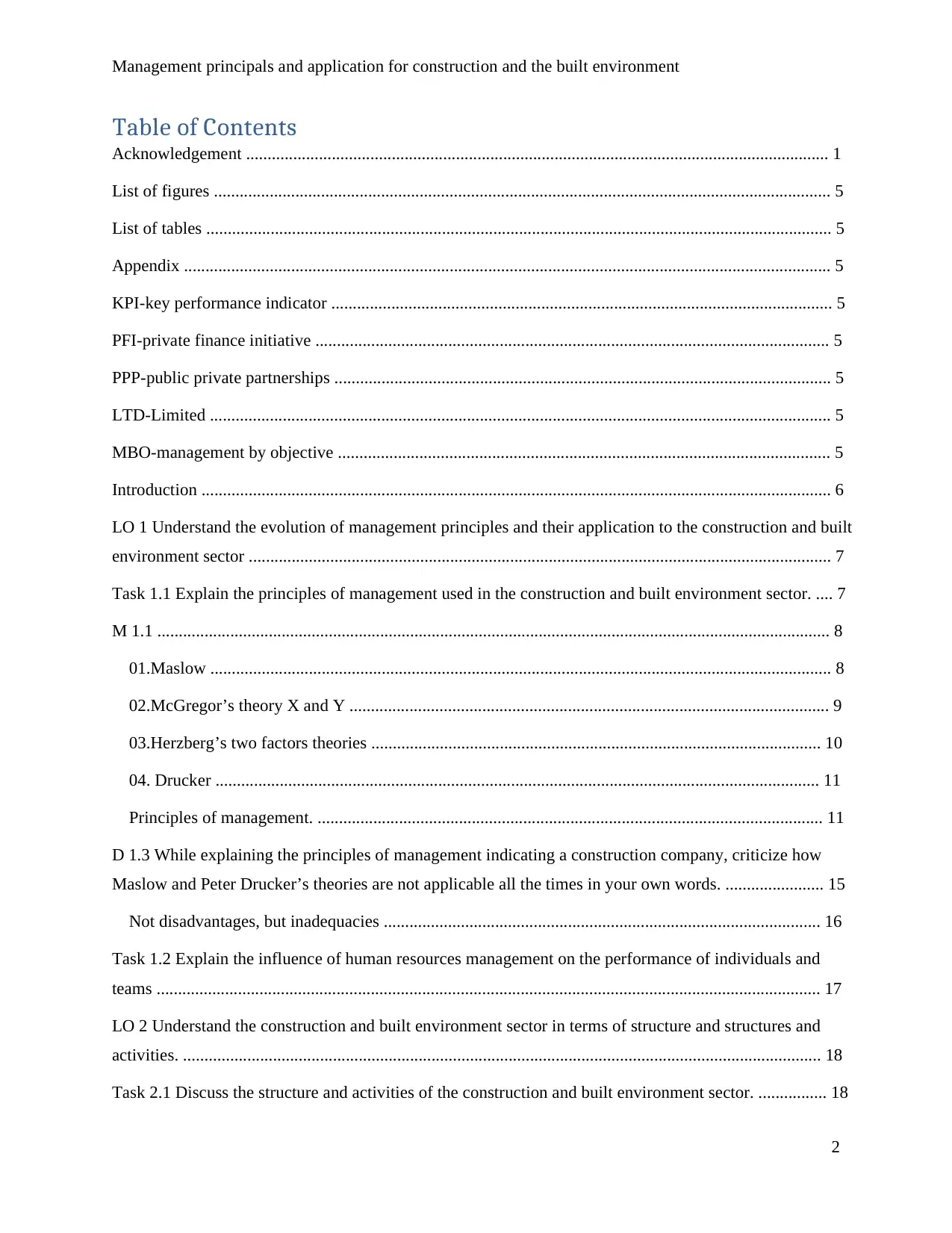
Management principals and application for construction and the built environment
2
Table of Contents
Acknowledgement ........................................................................................................................................ 1
List of figures ................................................................................................................................................ 5
List of tables .................................................................................................................................................. 5
Appendix ....................................................................................................................................................... 5
KPI-key performance indicator ..................................................................................................................... 5
PFI-private finance initiative ........................................................................................................................ 5
PPP-public private partnerships .................................................................................................................... 5
LTD-Limited ................................................................................................................................................. 5
MBO-management by objective ................................................................................................................... 5
Introduction ................................................................................................................................................... 6
LO 1 Understand the evolution of management principles and their application to the construction and built
environment sector ........................................................................................................................................ 7
Task 1.1 Explain the principles of management used in the construction and built environment sector. .... 7
M 1.1 ............................................................................................................................................................. 8
01.Maslow ................................................................................................................................................. 8
02.McGregor’s theory X and Y ................................................................................................................ 9
03.Herzberg’s two factors theories ......................................................................................................... 10
04. Drucker ............................................................................................................................................. 11
Principles of management. ...................................................................................................................... 11
D 1.3 While explaining the principles of management indicating a construction company, criticize how
Maslow and Peter Drucker’s theories are not applicable all the times in your own words. ....................... 15
Not disadvantages, but inadequacies ...................................................................................................... 16
Task 1.2 Explain the influence of human resources management on the performance of individuals and
teams ........................................................................................................................................................... 17
LO 2 Understand the construction and built environment sector in terms of structure and structures and
activities. ..................................................................................................................................................... 18
Task 2.1 Discuss the structure and activities of the construction and built environment sector. ................ 18
2
Table of Contents
Acknowledgement ........................................................................................................................................ 1
List of figures ................................................................................................................................................ 5
List of tables .................................................................................................................................................. 5
Appendix ....................................................................................................................................................... 5
KPI-key performance indicator ..................................................................................................................... 5
PFI-private finance initiative ........................................................................................................................ 5
PPP-public private partnerships .................................................................................................................... 5
LTD-Limited ................................................................................................................................................. 5
MBO-management by objective ................................................................................................................... 5
Introduction ................................................................................................................................................... 6
LO 1 Understand the evolution of management principles and their application to the construction and built
environment sector ........................................................................................................................................ 7
Task 1.1 Explain the principles of management used in the construction and built environment sector. .... 7
M 1.1 ............................................................................................................................................................. 8
01.Maslow ................................................................................................................................................. 8
02.McGregor’s theory X and Y ................................................................................................................ 9
03.Herzberg’s two factors theories ......................................................................................................... 10
04. Drucker ............................................................................................................................................. 11
Principles of management. ...................................................................................................................... 11
D 1.3 While explaining the principles of management indicating a construction company, criticize how
Maslow and Peter Drucker’s theories are not applicable all the times in your own words. ....................... 15
Not disadvantages, but inadequacies ...................................................................................................... 16
Task 1.2 Explain the influence of human resources management on the performance of individuals and
teams ........................................................................................................................................................... 17
LO 2 Understand the construction and built environment sector in terms of structure and structures and
activities. ..................................................................................................................................................... 18
Task 2.1 Discuss the structure and activities of the construction and built environment sector. ................ 18
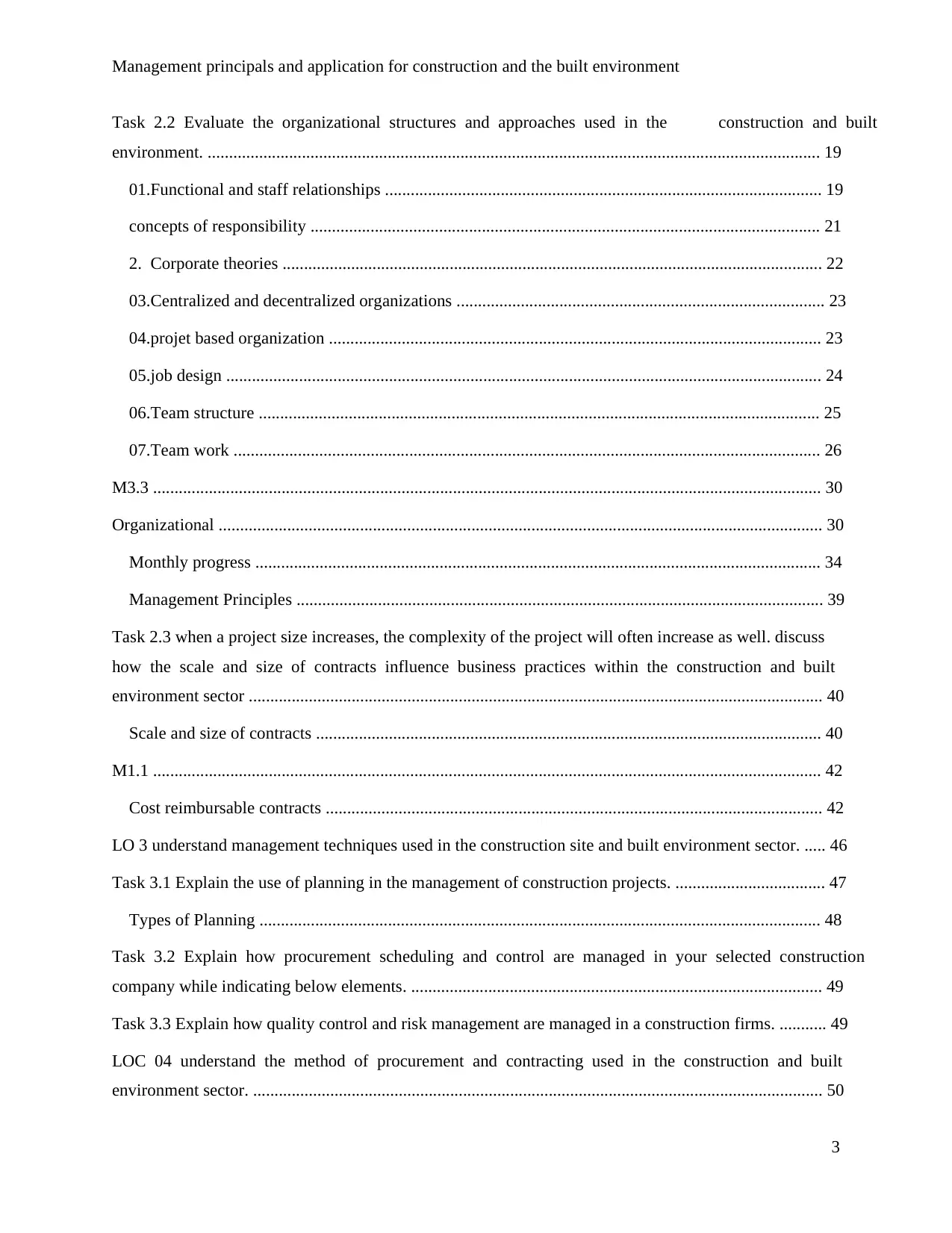
Management principals and application for construction and the built environment
3
Task 2.2 Evaluate the organizational structures and approaches used in the construction and built
environment. ............................................................................................................................................... 19
01.Functional and staff relationships ...................................................................................................... 19
concepts of responsibility ....................................................................................................................... 21
2. Corporate theories .............................................................................................................................. 22
03.Centralized and decentralized organizations ...................................................................................... 23
04.projet based organization ................................................................................................................... 23
05.job design ........................................................................................................................................... 24
06.Team structure ................................................................................................................................... 25
07.Team work ......................................................................................................................................... 26
M3.3 ............................................................................................................................................................ 30
Organizational ............................................................................................................................................. 30
Monthly progress .................................................................................................................................... 34
Management Principles ........................................................................................................................... 39
Task 2.3 when a project size increases, the complexity of the project will often increase as well. discuss
how the scale and size of contracts influence business practices within the construction and built
environment sector ...................................................................................................................................... 40
Scale and size of contracts ...................................................................................................................... 40
M1.1 ............................................................................................................................................................ 42
Cost reimbursable contracts .................................................................................................................... 42
LO 3 understand management techniques used in the construction site and built environment sector. ..... 46
Task 3.1 Explain the use of planning in the management of construction projects. ................................... 47
Types of Planning ................................................................................................................................... 48
Task 3.2 Explain how procurement scheduling and control are managed in your selected construction
company while indicating below elements. ................................................................................................ 49
Task 3.3 Explain how quality control and risk management are managed in a construction firms. ........... 49
LOC 04 understand the method of procurement and contracting used in the construction and built
environment sector. ..................................................................................................................................... 50
3
Task 2.2 Evaluate the organizational structures and approaches used in the construction and built
environment. ............................................................................................................................................... 19
01.Functional and staff relationships ...................................................................................................... 19
concepts of responsibility ....................................................................................................................... 21
2. Corporate theories .............................................................................................................................. 22
03.Centralized and decentralized organizations ...................................................................................... 23
04.projet based organization ................................................................................................................... 23
05.job design ........................................................................................................................................... 24
06.Team structure ................................................................................................................................... 25
07.Team work ......................................................................................................................................... 26
M3.3 ............................................................................................................................................................ 30
Organizational ............................................................................................................................................. 30
Monthly progress .................................................................................................................................... 34
Management Principles ........................................................................................................................... 39
Task 2.3 when a project size increases, the complexity of the project will often increase as well. discuss
how the scale and size of contracts influence business practices within the construction and built
environment sector ...................................................................................................................................... 40
Scale and size of contracts ...................................................................................................................... 40
M1.1 ............................................................................................................................................................ 42
Cost reimbursable contracts .................................................................................................................... 42
LO 3 understand management techniques used in the construction site and built environment sector. ..... 46
Task 3.1 Explain the use of planning in the management of construction projects. ................................... 47
Types of Planning ................................................................................................................................... 48
Task 3.2 Explain how procurement scheduling and control are managed in your selected construction
company while indicating below elements. ................................................................................................ 49
Task 3.3 Explain how quality control and risk management are managed in a construction firms. ........... 49
LOC 04 understand the method of procurement and contracting used in the construction and built
environment sector. ..................................................................................................................................... 50
⊘ This is a preview!⊘
Do you want full access?
Subscribe today to unlock all pages.

Trusted by 1+ million students worldwide
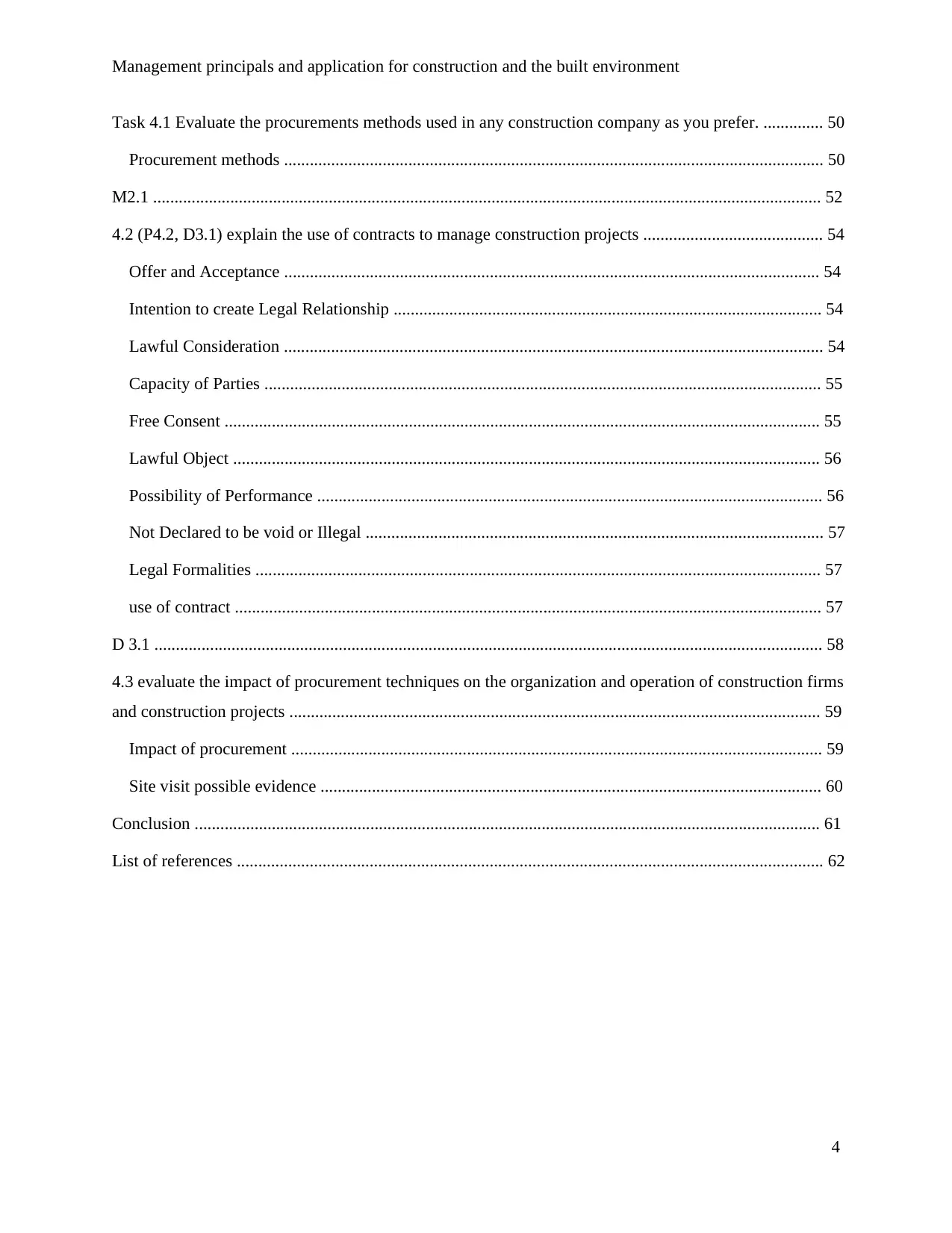
Management principals and application for construction and the built environment
4
Task 4.1 Evaluate the procurements methods used in any construction company as you prefer. .............. 50
Procurement methods .............................................................................................................................. 50
M2.1 ............................................................................................................................................................ 52
4.2 (P4.2, D3.1) explain the use of contracts to manage construction projects .......................................... 54
Offer and Acceptance ............................................................................................................................. 54
Intention to create Legal Relationship .................................................................................................... 54
Lawful Consideration .............................................................................................................................. 54
Capacity of Parties .................................................................................................................................. 55
Free Consent ........................................................................................................................................... 55
Lawful Object ......................................................................................................................................... 56
Possibility of Performance ...................................................................................................................... 56
Not Declared to be void or Illegal ........................................................................................................... 57
Legal Formalities .................................................................................................................................... 57
use of contract ......................................................................................................................................... 57
D 3.1 ............................................................................................................................................................ 58
4.3 evaluate the impact of procurement techniques on the organization and operation of construction firms
and construction projects ............................................................................................................................ 59
Impact of procurement ............................................................................................................................ 59
Site visit possible evidence ..................................................................................................................... 60
Conclusion .................................................................................................................................................. 61
List of references ......................................................................................................................................... 62
4
Task 4.1 Evaluate the procurements methods used in any construction company as you prefer. .............. 50
Procurement methods .............................................................................................................................. 50
M2.1 ............................................................................................................................................................ 52
4.2 (P4.2, D3.1) explain the use of contracts to manage construction projects .......................................... 54
Offer and Acceptance ............................................................................................................................. 54
Intention to create Legal Relationship .................................................................................................... 54
Lawful Consideration .............................................................................................................................. 54
Capacity of Parties .................................................................................................................................. 55
Free Consent ........................................................................................................................................... 55
Lawful Object ......................................................................................................................................... 56
Possibility of Performance ...................................................................................................................... 56
Not Declared to be void or Illegal ........................................................................................................... 57
Legal Formalities .................................................................................................................................... 57
use of contract ......................................................................................................................................... 57
D 3.1 ............................................................................................................................................................ 58
4.3 evaluate the impact of procurement techniques on the organization and operation of construction firms
and construction projects ............................................................................................................................ 59
Impact of procurement ............................................................................................................................ 59
Site visit possible evidence ..................................................................................................................... 60
Conclusion .................................................................................................................................................. 61
List of references ......................................................................................................................................... 62
Paraphrase This Document
Need a fresh take? Get an instant paraphrase of this document with our AI Paraphraser
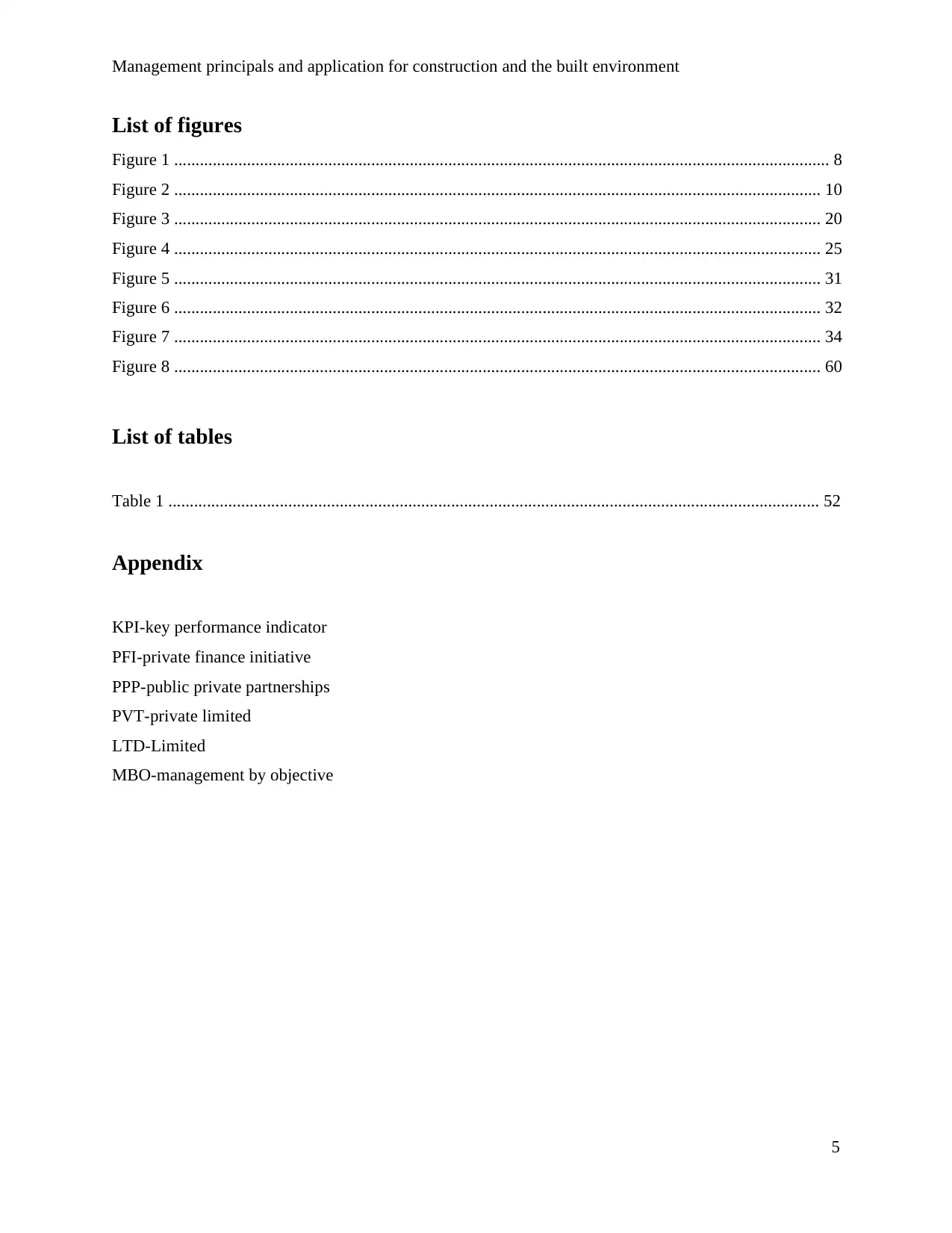
Management principals and application for construction and the built environment
5
List of figures
Figure 1 ......................................................................................................................................................... 8
Figure 2 ....................................................................................................................................................... 10
Figure 3 ....................................................................................................................................................... 20
Figure 4 ....................................................................................................................................................... 25
Figure 5 ....................................................................................................................................................... 31
Figure 6 ....................................................................................................................................................... 32
Figure 7 ....................................................................................................................................................... 34
Figure 8 ....................................................................................................................................................... 60
List of tables
Table 1 ........................................................................................................................................................ 52
Appendix
KPI-key performance indicator
PFI-private finance initiative
PPP-public private partnerships
PVT-private limited
LTD-Limited
MBO-management by objective
5
List of figures
Figure 1 ......................................................................................................................................................... 8
Figure 2 ....................................................................................................................................................... 10
Figure 3 ....................................................................................................................................................... 20
Figure 4 ....................................................................................................................................................... 25
Figure 5 ....................................................................................................................................................... 31
Figure 6 ....................................................................................................................................................... 32
Figure 7 ....................................................................................................................................................... 34
Figure 8 ....................................................................................................................................................... 60
List of tables
Table 1 ........................................................................................................................................................ 52
Appendix
KPI-key performance indicator
PFI-private finance initiative
PPP-public private partnerships
PVT-private limited
LTD-Limited
MBO-management by objective
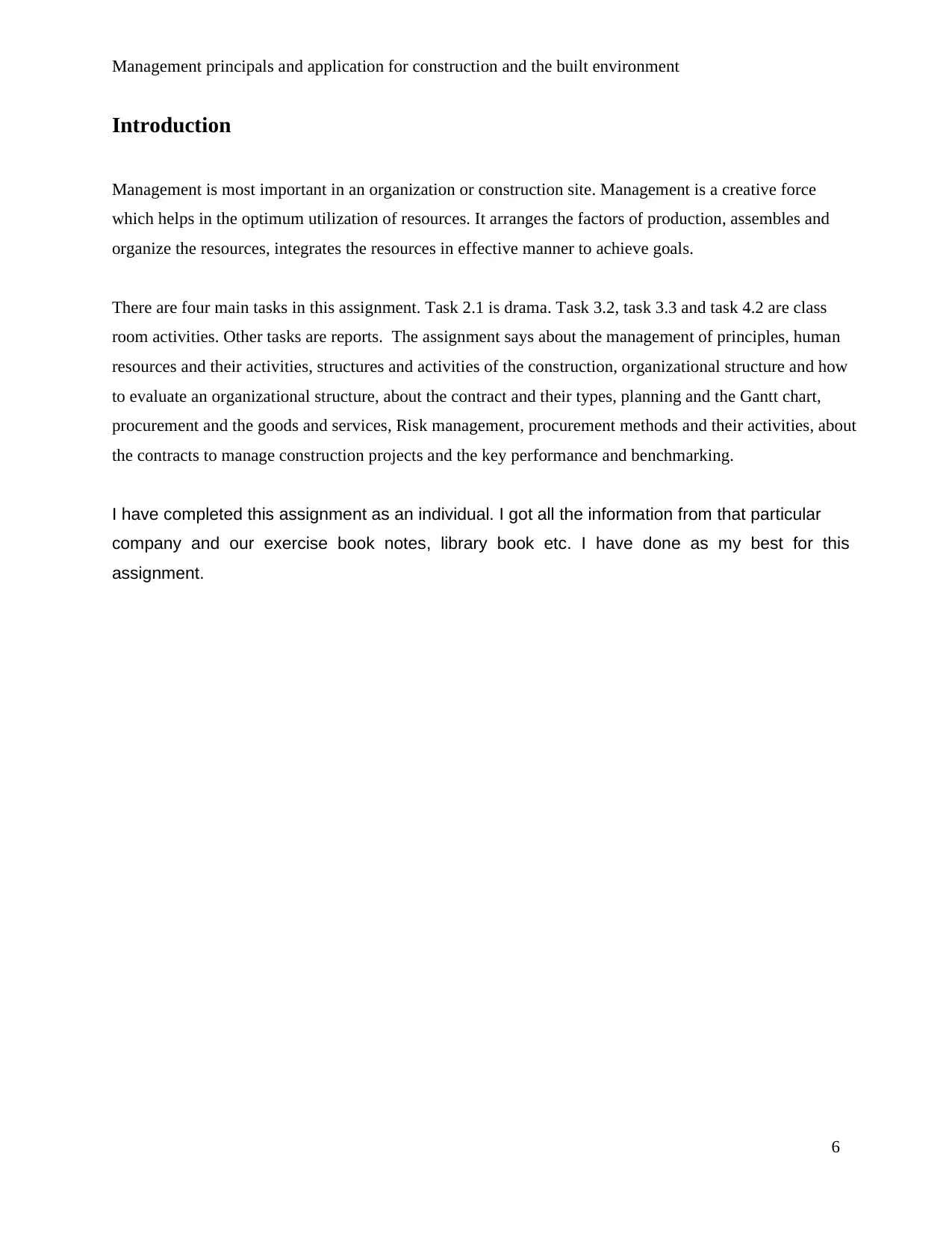
Management principals and application for construction and the built environment
6
Introduction
Management is most important in an organization or construction site. Management is a creative force
which helps in the optimum utilization of resources. It arranges the factors of production, assembles and
organize the resources, integrates the resources in effective manner to achieve goals.
There are four main tasks in this assignment. Task 2.1 is drama. Task 3.2, task 3.3 and task 4.2 are class
room activities. Other tasks are reports. The assignment says about the management of principles, human
resources and their activities, structures and activities of the construction, organizational structure and how
to evaluate an organizational structure, about the contract and their types, planning and the Gantt chart,
procurement and the goods and services, Risk management, procurement methods and their activities, about
the contracts to manage construction projects and the key performance and benchmarking.
I have completed this assignment as an individual. I got all the information from that particular
company and our exercise book notes, library book etc. I have done as my best for this
assignment.
6
Introduction
Management is most important in an organization or construction site. Management is a creative force
which helps in the optimum utilization of resources. It arranges the factors of production, assembles and
organize the resources, integrates the resources in effective manner to achieve goals.
There are four main tasks in this assignment. Task 2.1 is drama. Task 3.2, task 3.3 and task 4.2 are class
room activities. Other tasks are reports. The assignment says about the management of principles, human
resources and their activities, structures and activities of the construction, organizational structure and how
to evaluate an organizational structure, about the contract and their types, planning and the Gantt chart,
procurement and the goods and services, Risk management, procurement methods and their activities, about
the contracts to manage construction projects and the key performance and benchmarking.
I have completed this assignment as an individual. I got all the information from that particular
company and our exercise book notes, library book etc. I have done as my best for this
assignment.
⊘ This is a preview!⊘
Do you want full access?
Subscribe today to unlock all pages.

Trusted by 1+ million students worldwide
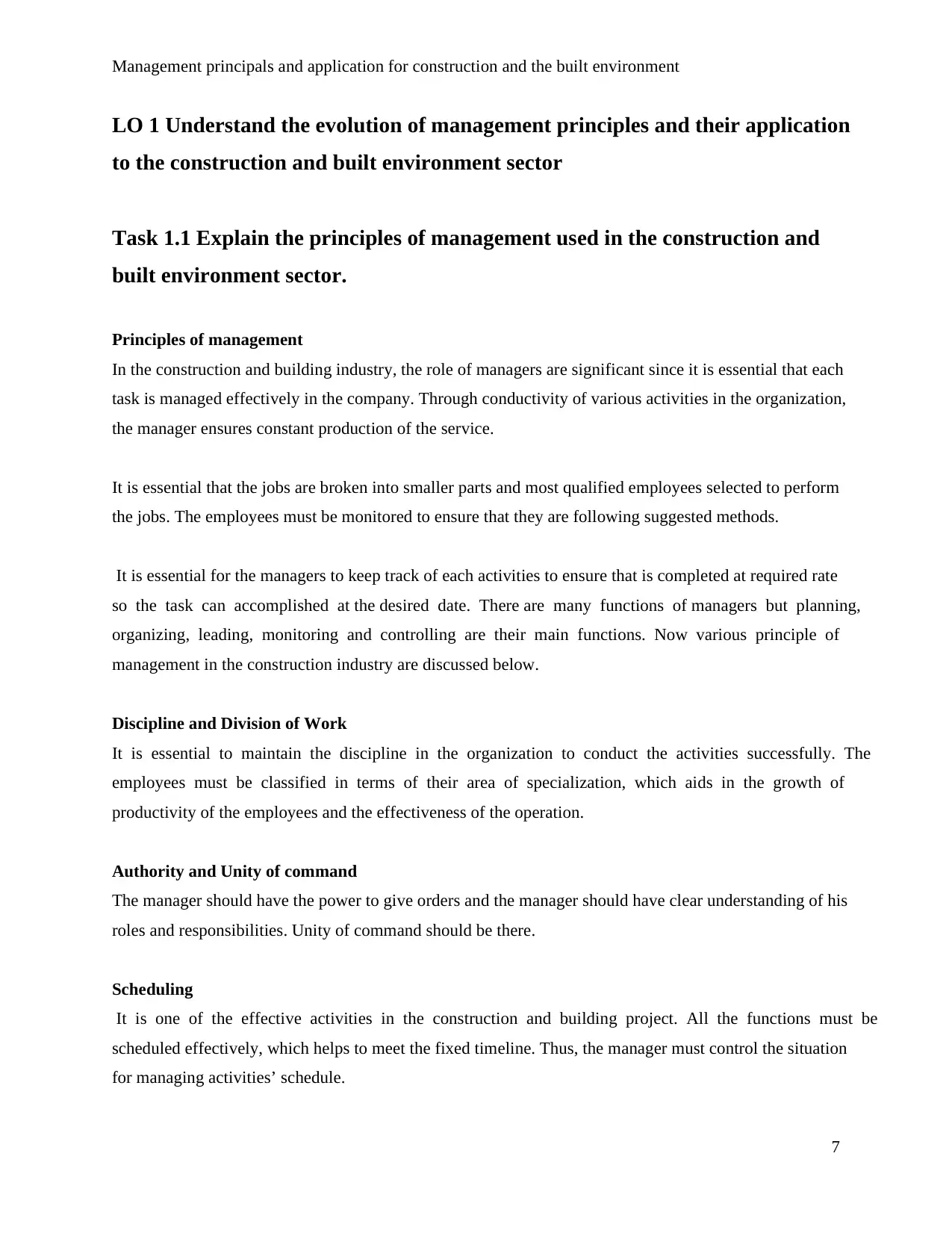
Management principals and application for construction and the built environment
7
LO 1 Understand the evolution of management principles and their application
to the construction and built environment sector
Task 1.1 Explain the principles of management used in the construction and
built environment sector.
Principles of management
In the construction and building industry, the role of managers are significant since it is essential that each
task is managed effectively in the company. Through conductivity of various activities in the organization,
the manager ensures constant production of the service.
It is essential that the jobs are broken into smaller parts and most qualified employees selected to perform
the jobs. The employees must be monitored to ensure that they are following suggested methods.
It is essential for the managers to keep track of each activities to ensure that is completed at required rate
so the task can accomplished at the desired date. There are many functions of managers but planning,
organizing, leading, monitoring and controlling are their main functions. Now various principle of
management in the construction industry are discussed below.
Discipline and Division of Work
It is essential to maintain the discipline in the organization to conduct the activities successfully. The
employees must be classified in terms of their area of specialization, which aids in the growth of
productivity of the employees and the effectiveness of the operation.
Authority and Unity of command
The manager should have the power to give orders and the manager should have clear understanding of his
roles and responsibilities. Unity of command should be there.
Scheduling
It is one of the effective activities in the construction and building project. All the functions must be
scheduled effectively, which helps to meet the fixed timeline. Thus, the manager must control the situation
for managing activities’ schedule.
7
LO 1 Understand the evolution of management principles and their application
to the construction and built environment sector
Task 1.1 Explain the principles of management used in the construction and
built environment sector.
Principles of management
In the construction and building industry, the role of managers are significant since it is essential that each
task is managed effectively in the company. Through conductivity of various activities in the organization,
the manager ensures constant production of the service.
It is essential that the jobs are broken into smaller parts and most qualified employees selected to perform
the jobs. The employees must be monitored to ensure that they are following suggested methods.
It is essential for the managers to keep track of each activities to ensure that is completed at required rate
so the task can accomplished at the desired date. There are many functions of managers but planning,
organizing, leading, monitoring and controlling are their main functions. Now various principle of
management in the construction industry are discussed below.
Discipline and Division of Work
It is essential to maintain the discipline in the organization to conduct the activities successfully. The
employees must be classified in terms of their area of specialization, which aids in the growth of
productivity of the employees and the effectiveness of the operation.
Authority and Unity of command
The manager should have the power to give orders and the manager should have clear understanding of his
roles and responsibilities. Unity of command should be there.
Scheduling
It is one of the effective activities in the construction and building project. All the functions must be
scheduled effectively, which helps to meet the fixed timeline. Thus, the manager must control the situation
for managing activities’ schedule.
Paraphrase This Document
Need a fresh take? Get an instant paraphrase of this document with our AI Paraphraser
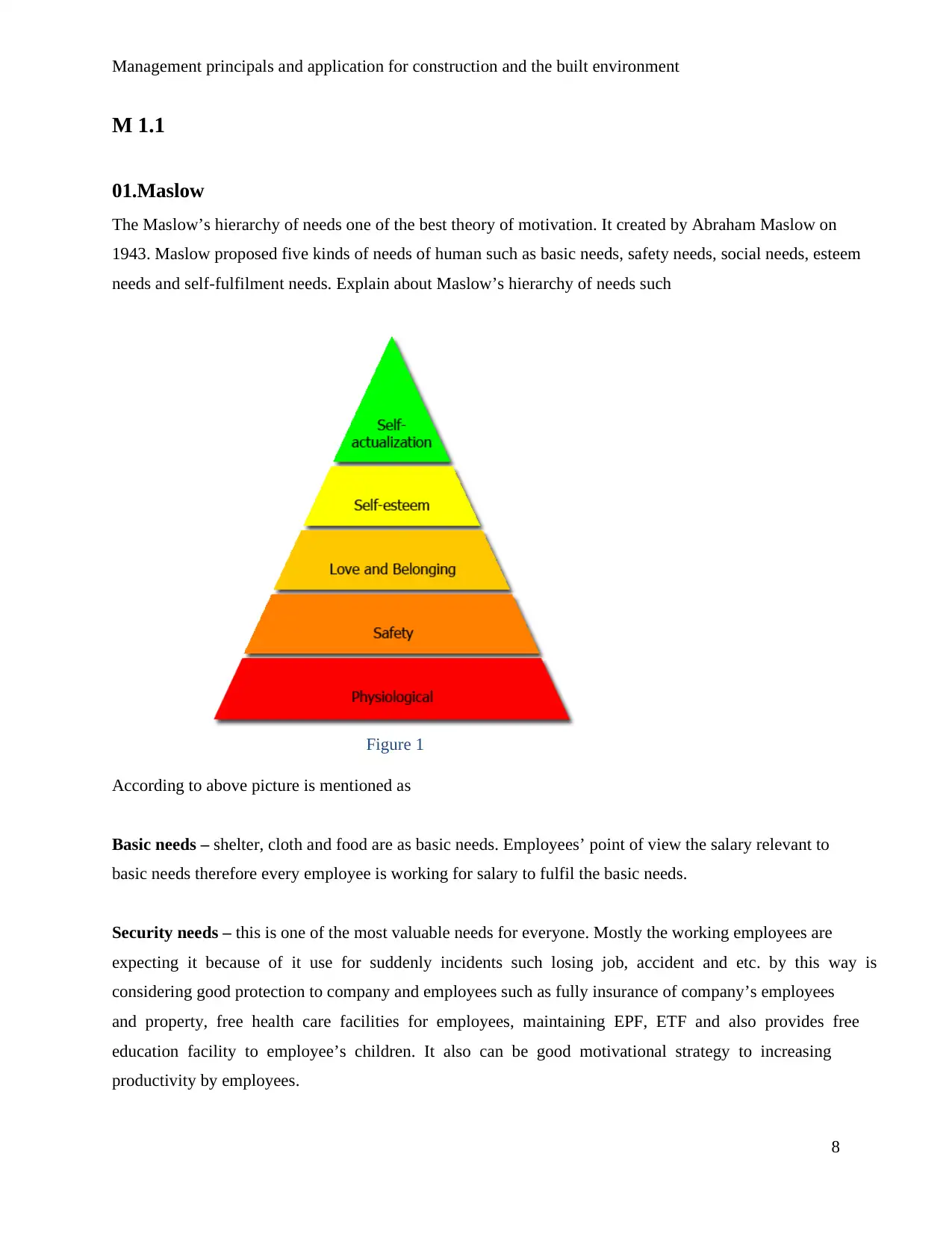
Management principals and application for construction and the built environment
8
M 1.1
01.Maslow
The Maslow’s hierarchy of needs one of the best theory of motivation. It created by Abraham Maslow on
1943. Maslow proposed five kinds of needs of human such as basic needs, safety needs, social needs, esteem
needs and self-fulfilment needs. Explain about Maslow’s hierarchy of needs such
According to above picture is mentioned as
Basic needs – shelter, cloth and food are as basic needs. Employees’ point of view the salary relevant to
basic needs therefore every employee is working for salary to fulfil the basic needs.
Security needs – this is one of the most valuable needs for everyone. Mostly the working employees are
expecting it because of it use for suddenly incidents such losing job, accident and etc. by this way is
considering good protection to company and employees such as fully insurance of company’s employees
and property, free health care facilities for employees, maintaining EPF, ETF and also provides free
education facility to employee’s children. It also can be good motivational strategy to increasing
productivity by employees.
Figure 1
8
M 1.1
01.Maslow
The Maslow’s hierarchy of needs one of the best theory of motivation. It created by Abraham Maslow on
1943. Maslow proposed five kinds of needs of human such as basic needs, safety needs, social needs, esteem
needs and self-fulfilment needs. Explain about Maslow’s hierarchy of needs such
According to above picture is mentioned as
Basic needs – shelter, cloth and food are as basic needs. Employees’ point of view the salary relevant to
basic needs therefore every employee is working for salary to fulfil the basic needs.
Security needs – this is one of the most valuable needs for everyone. Mostly the working employees are
expecting it because of it use for suddenly incidents such losing job, accident and etc. by this way is
considering good protection to company and employees such as fully insurance of company’s employees
and property, free health care facilities for employees, maintaining EPF, ETF and also provides free
education facility to employee’s children. It also can be good motivational strategy to increasing
productivity by employees.
Figure 1
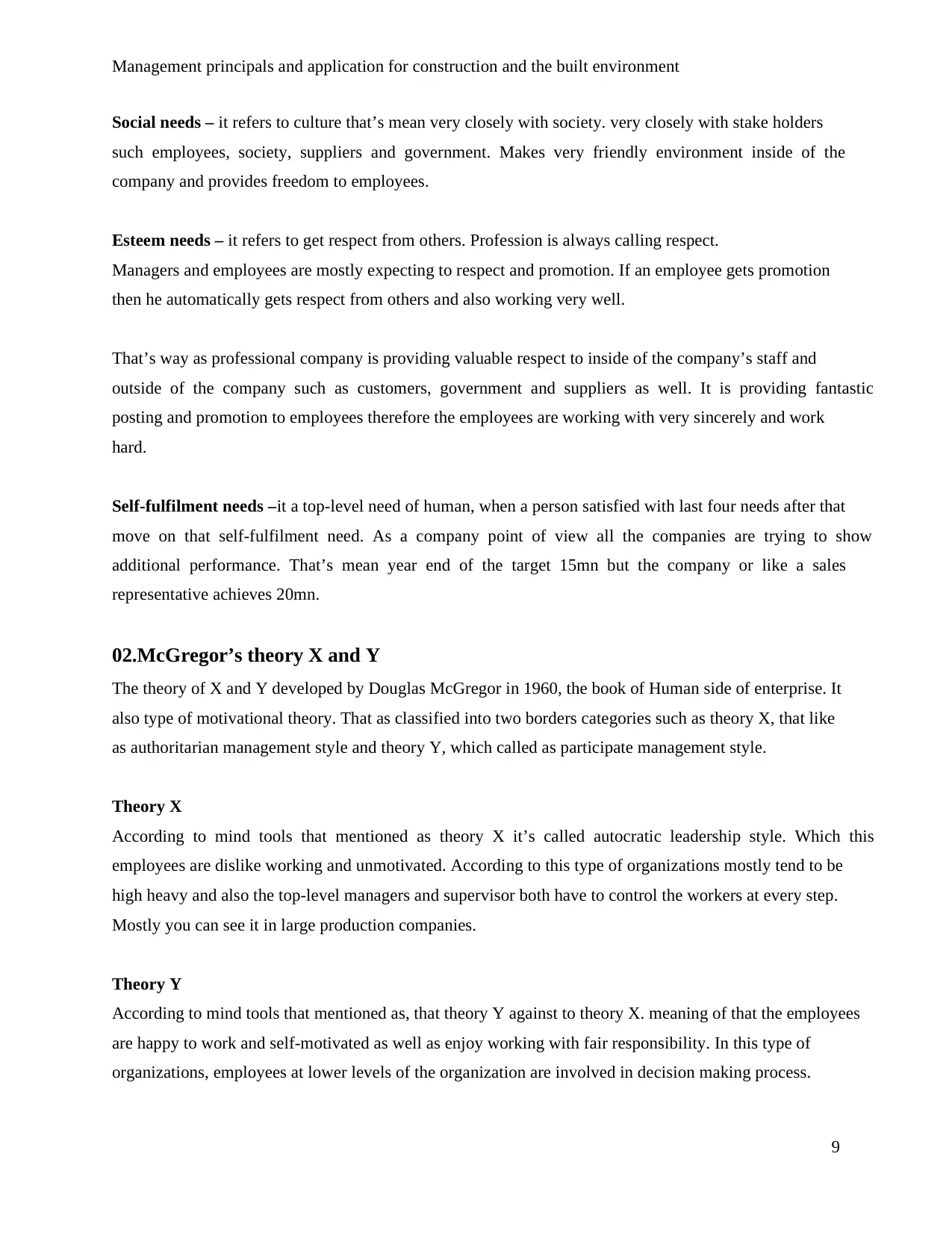
Management principals and application for construction and the built environment
9
Social needs – it refers to culture that’s mean very closely with society. very closely with stake holders
such employees, society, suppliers and government. Makes very friendly environment inside of the
company and provides freedom to employees.
Esteem needs – it refers to get respect from others. Profession is always calling respect.
Managers and employees are mostly expecting to respect and promotion. If an employee gets promotion
then he automatically gets respect from others and also working very well.
That’s way as professional company is providing valuable respect to inside of the company’s staff and
outside of the company such as customers, government and suppliers as well. It is providing fantastic
posting and promotion to employees therefore the employees are working with very sincerely and work
hard.
Self-fulfilment needs –it a top-level need of human, when a person satisfied with last four needs after that
move on that self-fulfilment need. As a company point of view all the companies are trying to show
additional performance. That’s mean year end of the target 15mn but the company or like a sales
representative achieves 20mn.
02.McGregor’s theory X and Y
The theory of X and Y developed by Douglas McGregor in 1960, the book of Human side of enterprise. It
also type of motivational theory. That as classified into two borders categories such as theory X, that like
as authoritarian management style and theory Y, which called as participate management style.
Theory X
According to mind tools that mentioned as theory X it’s called autocratic leadership style. Which this
employees are dislike working and unmotivated. According to this type of organizations mostly tend to be
high heavy and also the top-level managers and supervisor both have to control the workers at every step.
Mostly you can see it in large production companies.
Theory Y
According to mind tools that mentioned as, that theory Y against to theory X. meaning of that the employees
are happy to work and self-motivated as well as enjoy working with fair responsibility. In this type of
organizations, employees at lower levels of the organization are involved in decision making process.
9
Social needs – it refers to culture that’s mean very closely with society. very closely with stake holders
such employees, society, suppliers and government. Makes very friendly environment inside of the
company and provides freedom to employees.
Esteem needs – it refers to get respect from others. Profession is always calling respect.
Managers and employees are mostly expecting to respect and promotion. If an employee gets promotion
then he automatically gets respect from others and also working very well.
That’s way as professional company is providing valuable respect to inside of the company’s staff and
outside of the company such as customers, government and suppliers as well. It is providing fantastic
posting and promotion to employees therefore the employees are working with very sincerely and work
hard.
Self-fulfilment needs –it a top-level need of human, when a person satisfied with last four needs after that
move on that self-fulfilment need. As a company point of view all the companies are trying to show
additional performance. That’s mean year end of the target 15mn but the company or like a sales
representative achieves 20mn.
02.McGregor’s theory X and Y
The theory of X and Y developed by Douglas McGregor in 1960, the book of Human side of enterprise. It
also type of motivational theory. That as classified into two borders categories such as theory X, that like
as authoritarian management style and theory Y, which called as participate management style.
Theory X
According to mind tools that mentioned as theory X it’s called autocratic leadership style. Which this
employees are dislike working and unmotivated. According to this type of organizations mostly tend to be
high heavy and also the top-level managers and supervisor both have to control the workers at every step.
Mostly you can see it in large production companies.
Theory Y
According to mind tools that mentioned as, that theory Y against to theory X. meaning of that the employees
are happy to work and self-motivated as well as enjoy working with fair responsibility. In this type of
organizations, employees at lower levels of the organization are involved in decision making process.
⊘ This is a preview!⊘
Do you want full access?
Subscribe today to unlock all pages.

Trusted by 1+ million students worldwide
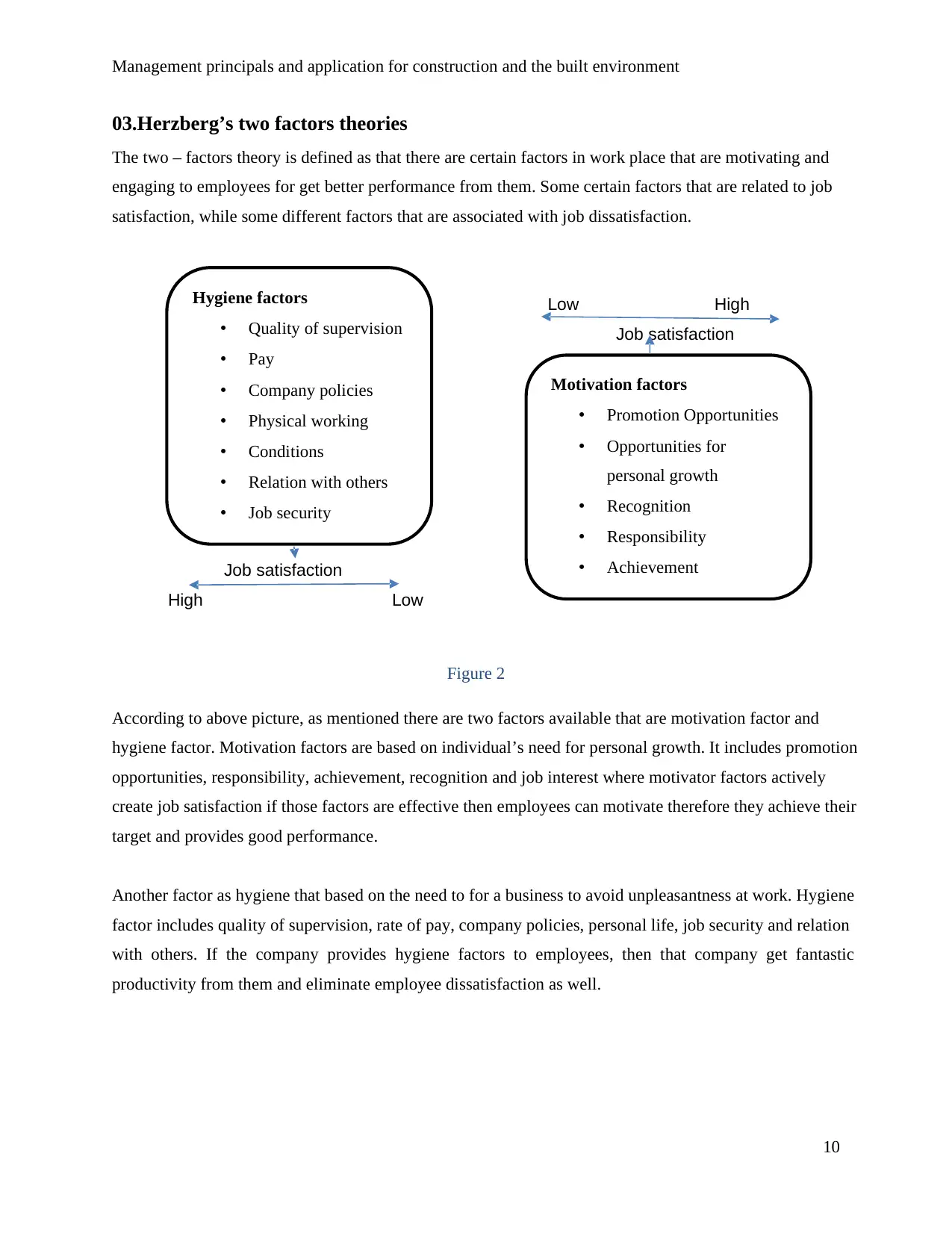
Management principals and application for construction and the built environment
10
03.Herzberg’s two factors theories
The two – factors theory is defined as that there are certain factors in work place that are motivating and
engaging to employees for get better performance from them. Some certain factors that are related to job
satisfaction, while some different factors that are associated with job dissatisfaction.
Low High
Job satisfaction
Job satisfaction
High Low
According to above picture, as mentioned there are two factors available that are motivation factor and
hygiene factor. Motivation factors are based on individual’s need for personal growth. It includes promotion
opportunities, responsibility, achievement, recognition and job interest where motivator factors actively
create job satisfaction if those factors are effective then employees can motivate therefore they achieve their
target and provides good performance.
Another factor as hygiene that based on the need to for a business to avoid unpleasantness at work. Hygiene
factor includes quality of supervision, rate of pay, company policies, personal life, job security and relation
with others. If the company provides hygiene factors to employees, then that company get fantastic
productivity from them and eliminate employee dissatisfaction as well.
Figure 2
Hygiene factors
• Quality of supervision
• Pay
• Company policies
• Physical working
• Conditions
• Relation with others
• Job security
Motivation factors
• Promotion Opportunities
• Opportunities for
personal growth
• Recognition
• Responsibility
• Achievement
10
03.Herzberg’s two factors theories
The two – factors theory is defined as that there are certain factors in work place that are motivating and
engaging to employees for get better performance from them. Some certain factors that are related to job
satisfaction, while some different factors that are associated with job dissatisfaction.
Low High
Job satisfaction
Job satisfaction
High Low
According to above picture, as mentioned there are two factors available that are motivation factor and
hygiene factor. Motivation factors are based on individual’s need for personal growth. It includes promotion
opportunities, responsibility, achievement, recognition and job interest where motivator factors actively
create job satisfaction if those factors are effective then employees can motivate therefore they achieve their
target and provides good performance.
Another factor as hygiene that based on the need to for a business to avoid unpleasantness at work. Hygiene
factor includes quality of supervision, rate of pay, company policies, personal life, job security and relation
with others. If the company provides hygiene factors to employees, then that company get fantastic
productivity from them and eliminate employee dissatisfaction as well.
Figure 2
Hygiene factors
• Quality of supervision
• Pay
• Company policies
• Physical working
• Conditions
• Relation with others
• Job security
Motivation factors
• Promotion Opportunities
• Opportunities for
personal growth
• Recognition
• Responsibility
• Achievement
Paraphrase This Document
Need a fresh take? Get an instant paraphrase of this document with our AI Paraphraser
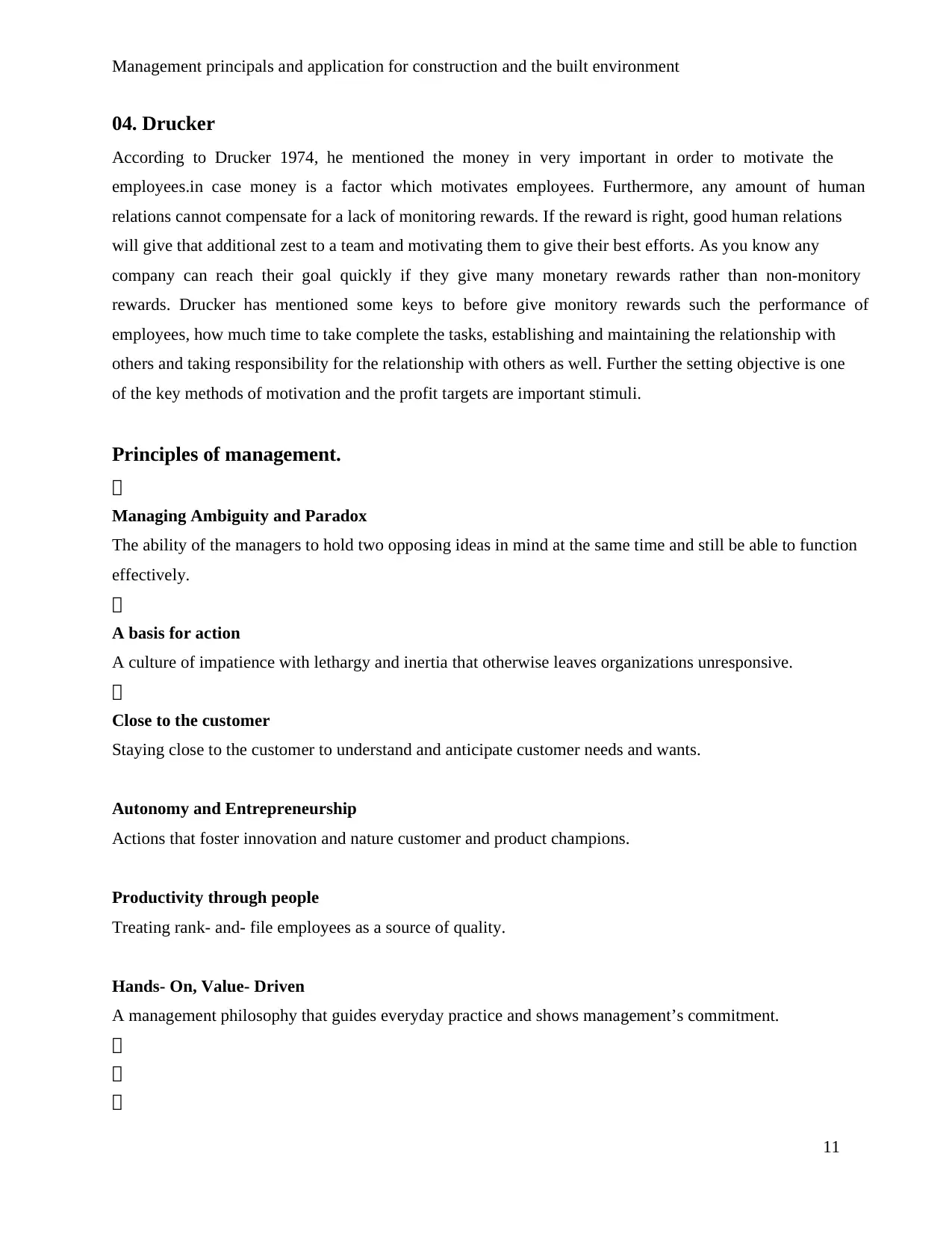
Management principals and application for construction and the built environment
11
04. Drucker
According to Drucker 1974, he mentioned the money in very important in order to motivate the
employees.in case money is a factor which motivates employees. Furthermore, any amount of human
relations cannot compensate for a lack of monitoring rewards. If the reward is right, good human relations
will give that additional zest to a team and motivating them to give their best efforts. As you know any
company can reach their goal quickly if they give many monetary rewards rather than non-monitory
rewards. Drucker has mentioned some keys to before give monitory rewards such the performance of
employees, how much time to take complete the tasks, establishing and maintaining the relationship with
others and taking responsibility for the relationship with others as well. Further the setting objective is one
of the key methods of motivation and the profit targets are important stimuli.
Principles of management.
Managing Ambiguity and Paradox
The ability of the managers to hold two opposing ideas in mind at the same time and still be able to function
effectively.
A basis for action
A culture of impatience with lethargy and inertia that otherwise leaves organizations unresponsive.
Close to the customer
Staying close to the customer to understand and anticipate customer needs and wants.
Autonomy and Entrepreneurship
Actions that foster innovation and nature customer and product champions.
Productivity through people
Treating rank- and- file employees as a source of quality.
Hands- On, Value- Driven
A management philosophy that guides everyday practice and shows management’s commitment.
11
04. Drucker
According to Drucker 1974, he mentioned the money in very important in order to motivate the
employees.in case money is a factor which motivates employees. Furthermore, any amount of human
relations cannot compensate for a lack of monitoring rewards. If the reward is right, good human relations
will give that additional zest to a team and motivating them to give their best efforts. As you know any
company can reach their goal quickly if they give many monetary rewards rather than non-monitory
rewards. Drucker has mentioned some keys to before give monitory rewards such the performance of
employees, how much time to take complete the tasks, establishing and maintaining the relationship with
others and taking responsibility for the relationship with others as well. Further the setting objective is one
of the key methods of motivation and the profit targets are important stimuli.
Principles of management.
Managing Ambiguity and Paradox
The ability of the managers to hold two opposing ideas in mind at the same time and still be able to function
effectively.
A basis for action
A culture of impatience with lethargy and inertia that otherwise leaves organizations unresponsive.
Close to the customer
Staying close to the customer to understand and anticipate customer needs and wants.
Autonomy and Entrepreneurship
Actions that foster innovation and nature customer and product champions.
Productivity through people
Treating rank- and- file employees as a source of quality.
Hands- On, Value- Driven
A management philosophy that guides everyday practice and shows management’s commitment.
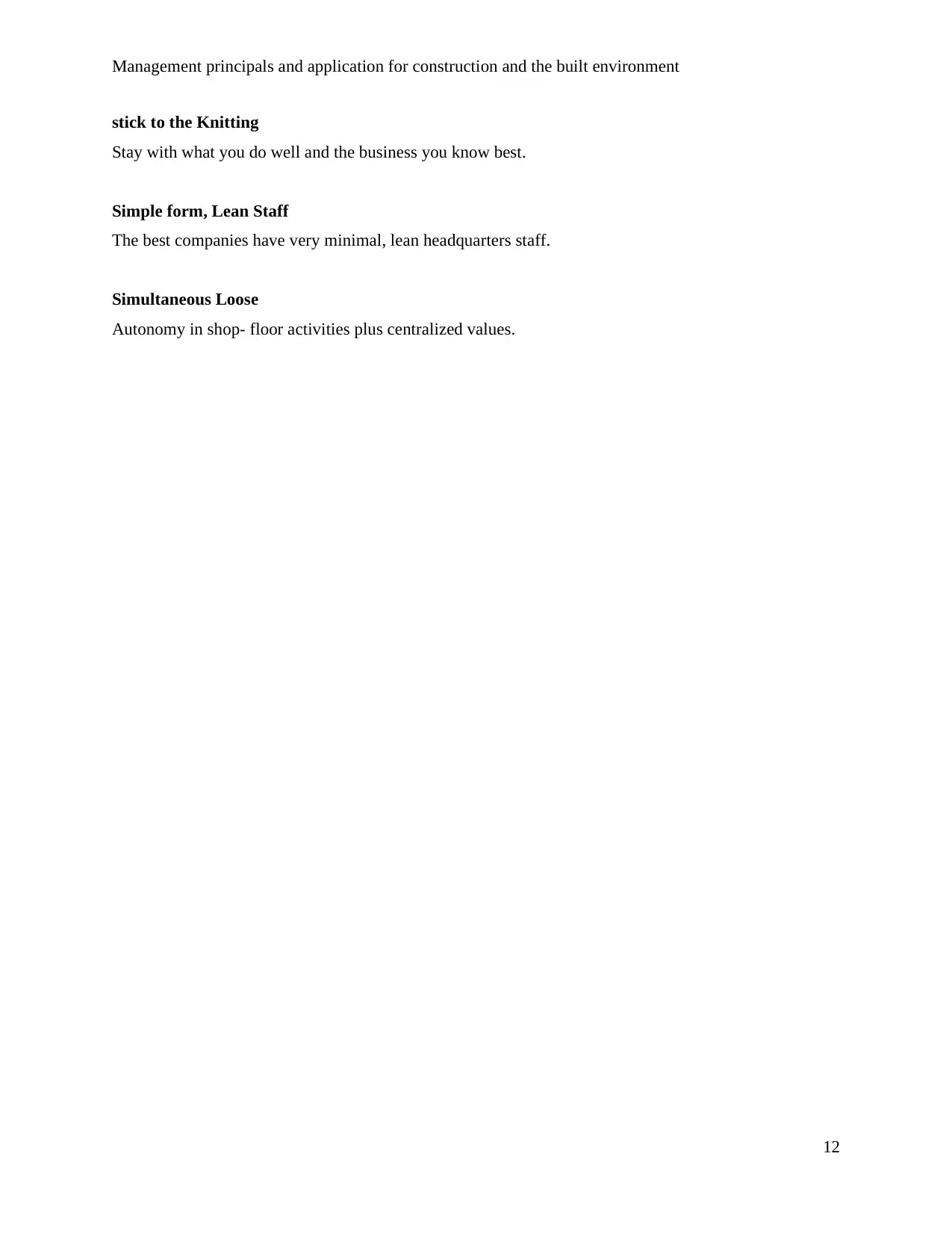
Management principals and application for construction and the built environment
12
stick to the Knitting
Stay with what you do well and the business you know best.
Simple form, Lean Staff
The best companies have very minimal, lean headquarters staff.
Simultaneous Loose
Autonomy in shop- floor activities plus centralized values.
12
stick to the Knitting
Stay with what you do well and the business you know best.
Simple form, Lean Staff
The best companies have very minimal, lean headquarters staff.
Simultaneous Loose
Autonomy in shop- floor activities plus centralized values.
⊘ This is a preview!⊘
Do you want full access?
Subscribe today to unlock all pages.

Trusted by 1+ million students worldwide
1 out of 62
Related Documents
Your All-in-One AI-Powered Toolkit for Academic Success.
+13062052269
info@desklib.com
Available 24*7 on WhatsApp / Email
![[object Object]](/_next/static/media/star-bottom.7253800d.svg)
Unlock your academic potential
Copyright © 2020–2025 A2Z Services. All Rights Reserved. Developed and managed by ZUCOL.





